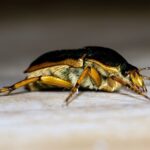Unveiling the natural world’s enigmas, “The Science Behind Cockroach Screams: Insect Behavior Uncovered” delves deep into the peculiar phenomenon of cockroach screams. A topic that has long puzzled entomologists and intrigued the general public alike, the question begs: why do cockroaches scream? As an experienced insect researcher and entomologist, my quest to understand the intricacies of evolutionary biology and behavior has led me to explore the fascinating communication methods employed by these resilient creatures. Drawing upon a wealth of knowledge and a profound passion for enlightenment, this article aims to shed light on the mesmerizing world of cockroach behavior, delving into the reasons behind their mysterious vocalizations.

Why do cockroaches scream?
Cockroaches, those infamous pests that send shivers down our spines, are often associated with eerie nighttime scuttling and, yes, even screaming. But hold on a minute—can cockroaches really scream? Let’s unravel the truth behind these mysterious insect sounds.
Contrary to popular belief, cockroaches do not possess vocal cords, which are essential for producing traditional screams like those we humans can let out. However, they do make noises that can sometimes be mistaken for screams. These noises are actually a form of communication among cockroaches.
So, how do cockroaches produce these sounds? Well, it turns out they employ a rather unique mechanism. They produce noises by rubbing their legs together or rubbing their wings together. When they engage in this leg or wing-rubbing activity, the insects forcefully expel air out of their specialized respiratory spiracles, which are tiny openings on their abdomen and other segments of their body.
The resulting sound, commonly referred to as hissing, is akin to what some might describe as screaming. But in reality, it is simply the hissing sound produced when cockroaches force air through their spiracles. It’s not screaming at all—it’s just their way of communicating with each other.
It’s important to understand the different forms of cockroach noises. For instance, there is stridulation, which is a scratching or rubbing sound made with their wings. Then there is crepitation, a crackling or popping sound as air passes through their lungs. Finally, we have sonation, which refers to an audible croak produced by some cockroach species.
But why do cockroaches hiss or “scream”? Well, there are a few occasions when they resort to this noisy behavior. First off, cockroaches may hiss when they feel threatened. If they sense danger approaching, they emit these hissing sounds as a warning to potential predators or other roaches. It’s like their way of saying, “Back off, I’m not to be messed with!”
Another reason for their hissing is during mating. Yes, love is in the air, and not just for birds and bees. When male cockroaches are in their romantic pursuit, they may serenade their potential partners with hissing sounds. It’s their version of a love song, a way to woo their desired mate. So, cockroaches make some oddly romantic music, don’t they?
Now that we’ve debunked the myth of cockroach screams, what other secrets might these resilient creatures be hiding? Apart from their unique communication methods, cockroaches possess some intriguing habits and behaviors. For example, they scavenge for food, feeding on plants, fruits, and other organic matter. Their attraction to dark, warm, and humid environments often leads to infestations in our homes. Although cockroaches are not dangerous to humans, their presence can be a sign of uncleanliness and can cause allergies in some individuals.
So, what can we do to combat these persistent pests? Well, there are various ways to get rid of them. First and foremost, a clean and tidy home is crucial. Cockroaches are attracted to food sources, so ensuring there are no crumbs or open food containers lying around can go a long way in deterring them. Sealing up potential entry points such as cracks and gaps in walls and windows can also help keep them out.
If these DIY methods don’t do the trick, you might consider using cockroach baits and traps. These are specifically designed to lure the critters in and eliminate them. Alternatively, seeking professional pest control services can provide a more comprehensive approach to cockroach eradication.
In conclusion, while cockroaches may not be capable of traditional screams, their hissing sounds have long been mistaken for screams of terror. Recognizing the true nature of their noise-making abilities—a form of communication rather than fear-induced screams—enhances our understanding of these resilient insects. So, the next time you hear a mysterious hissing sound, remember that it’s just a cockroach trying to make sense of the world in its own unique way.
“Cockroaches may not scream, but their hissing is a fascinating form of communication, allowing them to warn predators and serenade potential mates.”
Cockroaches are not just your average household pests. These creepy crawlers are hiding some seriously scary facts that will make your skin crawl. From their ability to survive without a head for weeks to their impressive speed and agility, you won’t believe what these resilient insects are capable of. If you’re brave enough, click here to uncover the spine-chilling truth about cockroaches: scary facts about cockroaches. But beware, this link is not for the faint of heart!
Cockroach Reproduction: Exploding Eggs and Newborn Babies
[youtube v=”CaazSx7Qb58″]
Introduction
Cockroaches are fascinating creatures with unique reproductive habits. In this article, we will explore the intriguing world of cockroach reproduction, focusing on the explosive nature of their eggs and the birth of their babies. Understanding these aspects can help homeowners better combat infestations and create a cleaner living environment.
Explosive Cockroach Eggs: A Surprising Phenomenon
Cockroaches, such as the Turkistan roaches, exhibit a fascinating reproductive behavior. Female cockroaches, easily distinguishable by their wings, can lay eggs that eventually lead to a significant number of babies. Interestingly, upon close observation, you may notice a single egg emerging from the female’s abdomen. This peculiar sight may seem trivial, but it is only the tip of the iceberg.
Exploding Eggs and the Birth of Roach Babies
The floor surrounding a mating pair of cockroaches can be covered in small, round objects called “Uthica.” These are not ordinary balls; each Uthica contains anywhere from 20 to 30 eggs, or even more. Cleaning up these Uthica and transferring them into a container reveals a mind-boggling event – the hatchlings of cockroach eggs.
A Mind-Blowing Number of Hatchlings
When the eggs hatch, you’ll be astounded by the sheer number of tiny cockroaches that emerge. Perfectly formed miniature replicas of their adult counterparts, these newborns hold the potential to increase their numbers exponentially. Don’t be fooled by the first batch; the sight of two eight-crates filled with these tiny creatures will leave you in awe.
Cockroach Noises: Hissing as a Form of Communication
Cockroaches may not possess vocal cords like humans, but they have adapted unique ways to communicate with each other. One of the most common methods is through hissing. Cockroaches create sounds by rubbing their legs or wings together, and this noise can often be mistaken for screaming.
Types of Cockroach Noises
Cockroaches produce various forms of vocalizations, each serving a different purpose. Stridulation is a sound created by the wings’ movement rubbing against each other. Crepitation refers to the noise produced by the cockroach’s body parts striking against one another, similar to the sound of snapping fingers. Lastly, sonation is a sound produced by vibrating special organs.
Hissing for Protection and Mating
Hissing is not merely a random act for cockroaches; it serves specific functions. When threatened, cockroaches hiss as a form of warning, not only to predators but also to other roaches. This noise lets potential dangers know that the cockroach is ready to defend itself. Additionally, male cockroaches may hiss during mating to attract potential partners.
Infestation Prevention and Control
Given their prolific reproductive capabilities and attraction to dark, warm, and humid environments, cockroaches can become a nuisance in homes. To prevent infestations and minimize their presence, several steps can be taken. It is crucial to maintain a clean and tidy home, as roaches are attracted to food debris and unattended spills. Sealing potential entry points, such as cracks and crevices, is also vital in stopping their invasion. Additionally, using cockroach baits and traps, or seeking professional pest control assistance, can ensure effective eradication.
“Understanding the intricate details of cockroach reproduction not only amazes but also highlights the importance of preventive measures in combating infestations.”

FAQ
Q: Do cockroaches actually scream?
A: No, cockroaches are not capable of screaming in the traditional sense as they lack vocal cords. However, they do produce noises that can sometimes be mistaken for screams.
Q: How do cockroaches produce their hissing noises?
A: Cockroaches produce noises by rubbing their legs together or rubbing their wings together. The sound is produced as the insect forcefully expels air out of their specialized respiratory spiracles (orifices).
Q: What are the specialized respiratory spiracles in cockroaches?
A: Cockroaches have specialized respiratory spiracles located on their abdomen, although spiracles can be found on all segments of their abdomen. These spiracles allow cockroaches to force air through and produce hissing noises.
Q: Why do people refer to cockroach noises as screams if they are actually hissing sounds?
A: Some people mistakenly refer to cockroach noises as screams, but in reality, they are hissing sounds. This misinterpretation may arise due to the loud and high-pitched nature of the hissing sounds produced by cockroaches.
Q: Why do cockroaches make hissing noises?
A: Cockroaches use their noise-making abilities to communicate with each other. They make hissing noises when they feel threatened or when they are mating. These sounds play a role in cockroach behavior and social interactions.












